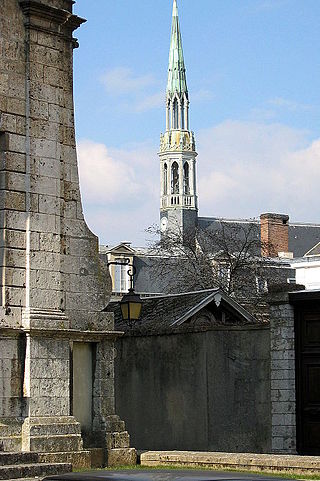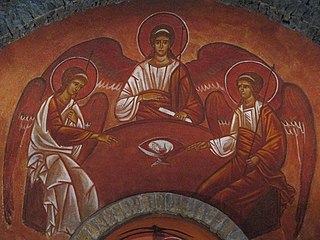The Canons Regular of St. Augustine are Catholic priests who live in community under a rule and are generally organised into religious orders, differing from both secular canons and other forms of religious life, such as clerics regular, designated by a partly similar terminology. As religious communities, they have laybrothers as part of the community.
A canoness is a member of a religious community of women, historically a stable community dedicated to the celebration of the Liturgy of the Hours in a particular church. The name corresponds to a canon, the male equivalent, and both roles share a common historical origin. As with the canons, there are two types: canonesses regular, who follow the Rule of St Augustine, and secular canonesses, who follow no monastic rule of life.

The Sodality of Our Lady, also known as the Sodality of the Blessed Virgin Mary, is a Roman Catholic Marian society founded in 1563 by young Belgian Jesuit Jean Leunis at the Roman College of the Society of Jesus. The modern Ignatian lay group Christian Life Community traces its origins to the first Sodality.
The Society of the Sisters of Saint Ursula of the Blessed Virgin is a Roman Catholic religious congregation of women founded in 1606 at Döle, France, by the Venerable Anne de Xainctonge (1587-1612). Its members are especially involved in teaching.
Anthonians applies to four Catholic Religious communities or Orders and a single Chaldean one, all under the patronage of St. Anthony the Hermit, father of monasticism, or professing to follow his rule.

The Third Order of Saint Dominic, also referred to as the Lay Fraternities of Saint Dominic or Lay Dominicans since 1972, is a Catholic third order which is part of the Dominican Order.
The Sisters of the Cenacle is a Roman Catholic Congregation founded in 1826 in the village of Lalouvesc (Ardèche), France. The founders were Saint Thérèse Couderc and diocesan priest Jean-Pierre Etienne Terme.

The Canonesses Regular of the Holy Sepulchre (CRSS), or Sepulchrine Canonesses, are a Catholic female religious order first documented in 1300. They were originally the female branch of the ancient religious order of that name, the Canons Regular of the Holy Sepulchre. The canonesses follow the Rule of St. Augustine.
The Sisters of the Blessed Sacrament and Our Lady is an enclosed religious order and a reform of the Dominican Order devoted to the perpetual adoration of the Blessed Sacrament. The congregation was founded in Marseille in 1659 by a Dominican priest, Anthony Le Quieu.

The Congregation of the Sisters of St. Paul of Chartres (SPC) is a Roman Catholic religious apostolic missionary congregation of pontifical right for teaching, nursing, visiting the poor and taking care of orphans, the old and infirm, and the mentally ill. It was founded in Levesville-la-Chenard, France, in 1696.
The Sisters of St. Anne (SSA) is a Catholic religious institute founded in 1850 in Vaudreuil, Quebec, Canada, by Marie Anne Blondin to promote the education of the rural children of the Province of Canada. Their vision is rooted and guided by Ignatian spirituality.

The Bernardine Cistercians of Esquermes are a small branch of the Cistercian Order. They follow the Rule of St Benedict, and co-operate with the apostolic mission of the Catholic Church through educational activities and hospitality. There are eight monasteries of nuns in six countries, united by a central Government.
The Dominican Sisters of Peace is a congregation of Dominican Sisters of apostolic life, founded on Easter Sunday, April 12, 2009, from the union of seven former Dominican foundations. With general offices in Columbus, Ohio, the congregation holds legal incorporation in the state of Kentucky, home of the founding community of earliest historical origin. In 2012, following a vote by their General Chapter, the Dominican sisters of Catherine de' Ricci became the eighth foundation to join the Dominican Sisters of Peace.

Hélène Marie Philippine de Chappotin de Neuville, known as Mary of the Passion, was a French religious sister and missionary, who founded the Franciscan Missionaries of Mary in British India in 1877, currently one of the largest religious institutes in the Catholic Church.

The Monastic Family of Bethlehem, of the Assumption of the Virgin and of Saint Bruno – or simply known as Monastic Brothers of Bethlehem and Monastic Sisters of Bethlehem – is a Roman Catholic institute of consecrated life.
The Missionary Sisters of the Immaculate Heart of Mary (I.C.M.) are a Roman Catholic religious institute of pontifical right of women, dedicated to the service of those in need in the Third World.
The Benedictine Sisters of Jesus Crucified are a congregation of contemplative Benedictine Religious Sisters which was founded in France in 1930. Their particular gift has been to make monastic life possible for women who might not normally be admitted to a monastery due to their state of health or their having a physical disability by all candidates deemed capable of living a monastic life regardless of their physical condition. For this they follow the Rule of St. Benedict with certain adaptations to make this possible.

Théodelinde Bourcin-Dubouché, known commonly as Marie-Thérèse of the Heart of Jesus, was a Roman Catholic French nun, artist, and founder of the Sisters of Adoration in Paris, France. The cause for her canonization has been formally accepted by the Holy See, and thus she has been declared "venerable".

The Sisters of Adoration, in full the Sisters of Reparative Adoration are a Catholic enclosed religious order of women that follows the religious rule of the Discalced Carmelite Order, established in 1848 by Théodelinde Bourcin-Dubouché. They are dedicated to perpetual adoration of the Blessed Sacrament and to reparation to God for the sins of the world. To this end, they serve to help deepen the faith of laywomen though conducting spiritual retreats in their monasteries.

La Pairelle or its full name Centre Spirituel Ignatien La Pairelle is a Catholic spirituality and retreat centre in Wépion, Namur, Belgium. It was built in 1932 by the Jesuits and was designed by Albert Ghequière with a chapel built in the Gothic Revival style. It is located off Rue Marcel Lecomte on a hill in the district of Wépion in Namur, overlooking the River Meuse. It is the only French-speaking Jesuit retreat centre in Belgium.









